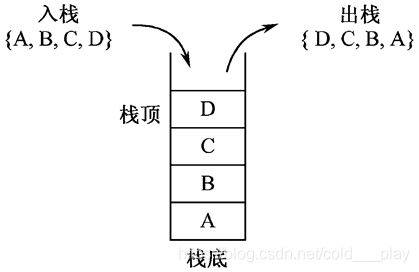栈
栈(stack)是一种特殊的线性表,其插入和删除操作只允许在线性表的一端进行。

栈的抽象数据类型
package pers.zhang.stack;
/**
* @author zhang
* @date 2020/1/16 - 14:05
*
* 栈接口,描述栈的抽象数据类型,泛型参数T表示数据元素的数据类型
*/
public interface SStack<T> {
//判断栈是否为空
boolean isEmpty();
//元素x入栈
void push(T x);
//出栈,返回栈顶元素
T pop();
//取出栈顶元素,未出栈
T get();
}
栈的实现
栈有两种基本的实现:
- 顺序栈:使用数组实现
- 链栈:使用栈节点实现

顺序栈

package pers.zhang.stack;
/**
* @author zhang
* @date 2020/1/16 - 14:12
*
* 顺序栈,实现栈接口
*/
public class SeqStack<T> implements SStack<T> {
//存储栈数据元素的Object数组
private Object element[];
//栈顶元素下表
private int top;
//构造容量为size的栈
public SeqStack(int size){
this.element = new Object[Math.abs(size)];
this.top = -1;
}
//默认构造,构造容量为64的空栈
public SeqStack(){
this(64);
}
//判断栈是否为空,若为空返回true
@Override
public boolean isEmpty() {
return this.top == -1;
}
//元素x入栈,空对象不操作
@Override
public void push(T x) {
if(x == null)
return;
if(this.top == element.length - 1){//栈满,需要扩容
Object[] temp = this.element;
this.element = new Object[temp.length * 2];//重新申请一个2倍容量的数组
for(int i = 0; i < temp.length; i++)//复制元素
this.element[i] = temp[i];
}
this.top++;//移动栈顶指针
this.element[this.top] = x;//入栈
}
//出栈,返回栈顶元素,若栈空返回null
@Override
public T pop() {
return this.top == -1 ? null : (T) this.element[this.top--];
}
//取出栈顶元素,未出栈,若栈空返回null
@Override
public T get() {
return this.top == -1 ? null : (T) this.element[this.top];
}
//返回栈所有元素的描述字符串,形式为“(,)”,算法同顺序表
@Override
public String toString(){
String str = "(";
if (this.top != -1)
str += this.element[this.top].toString();
for (int i= this.top - 1; i >= 0; i--)
str += ", "+this.element[i].toString();
return str + ") ";
}
}
链栈


节点类:
public class Node<T> {
//数据域,保存数据元素
public T data;
//地址域,引用后继节点
public Node<T> next;
public Node(){
this(null,null);
}
public Node(T data, Node<T> next){
this.data = data;
this.next = next;
}
public String toString(){
return this.data.toString();
}
public boolean equals(Object obj){
return obj == this || obj instanceof Node && this.data.equals(((Node<T>)obj).data);
}
}
链栈的实现:
package pers.zhang.stack;
import pers.zhang.linearList.LinearList;
import pers.zhang.linearList.Node;
/**
* @author zhang
* @date 2020/1/16 - 14:28
*
* 链栈,实现栈接口
*/
public class LinkedStack<T> implements SStack<T> {
//栈顶节点,同单链表节点一致
private Node<T> top;
//构造空栈
public LinkedStack(){
this.top = null;
}
//判断栈是否为空,若空返回true
@Override
public boolean isEmpty() {
return this.top == null;
}
//元素x入栈,空对象不操作
@Override
public void push(T x) {
if(x == null)
return;
this.top = new Node<>(x, this.top);//头插入,x节点作为新的栈顶
}
//出栈,返回栈顶元素,栈空返回null
@Override
public T pop() {
if(this.top == null)
return null;
T temp = this.top.data;//保存栈顶节点元素
this.top = this.top.next;//删除栈顶节点
return temp;
}
//取出栈顶元素,未出栈,空栈返回null
@Override
public T get() {
return this.top == null ? null : this.top.data;
}
//返回栈所有元素的描述字符串,形式为“(,)”。算法同不带头结点的单链表
public String toString(){
String str = "(";
for (Node<T> p = this.top; p != null; p = p.next){
str += p.data.toString();
if (p.next != null)
str += ", ";//不是最后一个结点时后加分隔符
}
return str + ")";//空表返回()
}
}
测试
package pers.zhang.stack;
/**
* @author zhang
* @date 2020/1/16 - 14:36
*/
public class Stack_ex {
public static void main(String args[])
{
/* SeqStack<String> stack = new SeqStack<String>(20);
System.out.print("Push: ");
char ch='a';
for(int i=0;i<5;i++)
{
String str = (char)(ch+i)+"";
stack.push(str);
System.out.print(str+" ");
}
*/
LinkedStack<Integer> stack = new LinkedStack<Integer>();
System.out.print("Push: ");
for (int i=1; i<=5; i++)
{
Integer intobj = new Integer(i);
stack.push(intobj);
System.out.print(intobj+" ");
}
System.out.println("\nStack: "+stack.toString());
System.out.print("Pop : ");
while(!stack.isEmpty()) //全部出栈
System.out.print(stack.pop().toString()+" ");
System.out.println();
}
}
输出如下:
Push: a b c d e
Stack: (e, d, c, b, a)
Pop : e d c b a
Push: 1 2 3 4 5
Stack: (5, 4, 3, 2, 1)
Pop : 5 4 3 2 1
